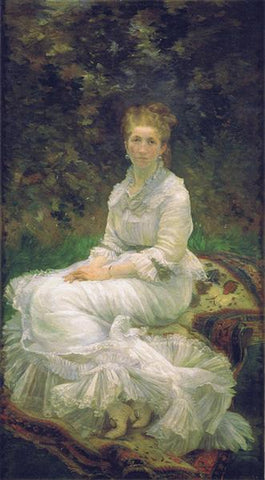Marie Bracquemond's name might not be as familiar as Monet or Renoir, but her impact on the Impressionist movement is undeniably profound. Born in 1840 in Brittany, France, Bracquemond's journey into the art world was marked by both her remarkable talent and the challenges she faced in a male-dominated field.

The Lady in white by Marie Bracquemond
Despite these obstacles, Bracquemond's work stood out for its vibrant use of color and light, hallmarks of Impressionist technique. She was one of the few women who exhibited alongside the likes of Monet and Degas, earning her a place in the "Les Trois Grandes Dames" of Impressionism alongside Berthe Morisot and Mary Cassatt. Yet, unlike her contemporaries, Bracquemond's legacy has not received the same level of recognition.
Bracquemond's artistic journey began under the guidance of Jean-Auguste-Dominique Ingres, who recognized her talent early on. However, her true passion lay with the Impressionists, whose approach to painting she found liberating. Her work often depicted domestic scenes and landscapes, imbued with a sensitivity and depth that reflected her personal experiences and challenges as a woman artist.

Three ladies with parasol (aka Three Graces) by Marie Bracquemond 1880
One of Bracquemond's most celebrated works is "On the Terrace at Sèvres," showcasing her skillful use of light and her ability to capture the subtleties of everyday life. Her paintings are characterized by a delicate yet confident brushwork, and a palette that embraced the Impressionist fascination with the effects of natural light.

On the Terrace at Sèvres by Marie Bracquemond 1880
Despite her contributions, Bracquemond's career was overshadowed by the constraints of her era and her husband, Félix Bracquemond, a notable but conservative artist who was less enthusiastic about the Impressionist movement. Her artistic output diminished significantly in her later years, as domestic responsibilities took precedence, and her work was further marginalized in the history of art.

The Umbrellas by Marie Bracquemond
Today, efforts are being made to reassess Marie Bracquemond's role and contributions to Impressionism. Exhibitions and research are bringing her work back into the public eye, highlighting her as a pioneering figure who challenged the conventions of her time through her art.

Le Gouter by Marie Bracquemond 1880
Marie Bracquemond's story is a testament to the resilience and talent of women artists who navigated the complexities of the art world in the 19th century. Her legacy, though overlooked for too long, offers inspiration and insight into the rich tapestry of Impressionist art, reminding us of the diverse voices that have shaped this movement.
